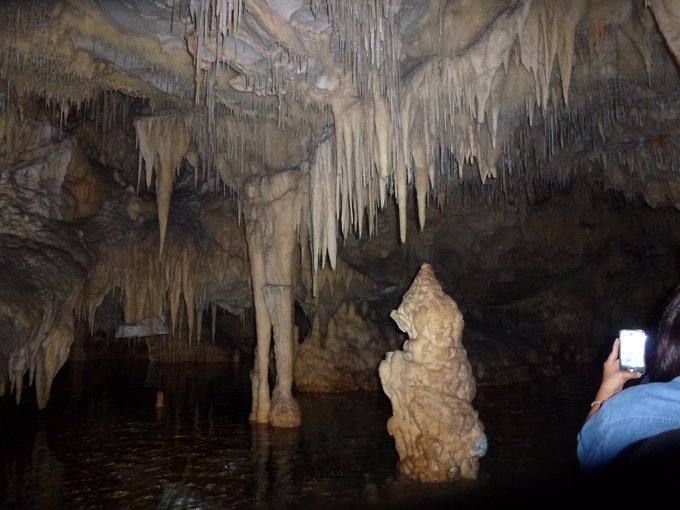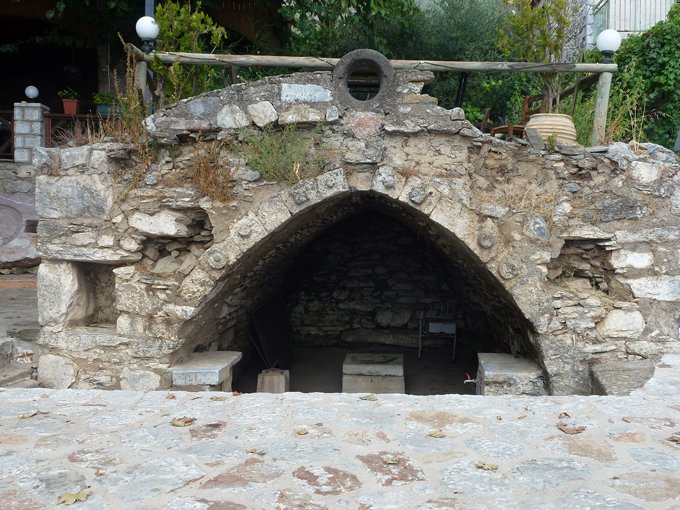Caves at Diros

Caves at Diros
Tuesday, 28th August, 2012.
Off we went in our hire car to find the caves at Diros. Jim drove through the town of Kalamata which is not easy as everyone thinks they have the right of way in the direction for the road to Diros. The road signs here are quite non-existent and if there is one the turning is there and there is no room for thinking about it. The mountain scenery and the roads down to the coastal villages were beautiful. We stopped for coffee at a bakery overlooking the bay where you sat outside under an umbrella watching everyone coming and going with bread, cakes, bread sticks and ice-creams. This bakery is obviously very popular and there was a steady flow of customers. Jim tried the hot apple custard pastry!
The caves at Diros are on the western coast of the Laconian peninsular in the Bay of Diros. The first existence of the caves was known in 1900 to the locals. It was not until 1949 when Yiannis and Anna Petrocheilou founders of the Hellenic Speleological Society began to explore it systematically. By 1960 they had explored and charted 1,600 metres while it is known today there is 14 kilometres of caves. In 1970 the first underwater exploration took place and it continues today both above and below the water with cave diving.
The cave began to be formed hundreds of thousands of years ago. The stalactites and stalagmites that are now beneath the water formed when the sea level was much lower than it is today. Stalactites have been found at a depth of 71 metres. The water that seeps into cracks in the limestone bedrock dissolves it. Drop by drop the deposits of dissolved carbonated limestone gradually form stalactites and stalagmites. The natural entrance to the cave has a diameter of half a metre and is very close to sea level. There were several other entrances that over years have gradually closed.
Inside the cave there has been found fossilised bones of panthers, hyenas, lions, deer, ferrets and the largest collection of hippopotamus bones in Europe.
The water in the cave is about 14 degrees centigrade while the air in the cave ranges from 16 to 19 degrees centigrade. We were taken in a little blue boat with a man on the back steering and using a wooden paddle on the rock in places to guide us through the tunnels. We were ducking down as there is not a lot of head room. Luckily, I was on a seat by myself and had a little space where as Jim and the gentleman next to him were confine to very little room for movement. Several times I thought one of them was going to get a shock but they kept ducking and all was okay. It did take the boy at the front three or four minutes to realise everytime he fidgeted the little boat rolled from side to side and everyone grasp. The boat journey took approximately 20 minutes and then we walked through the cave to the exit. The effort to get to the caves was well worth it as it was one of the best experiences of our summer.
On the way back we stopped for a late lunch early dinner in a very small village where there was no English spoken at all but we managed the menu. We sat under the trees in the shade enjoying the surroundings. There was an olive press mill and we bought a wonderful jar of olives from a gentleman selling them by the road. He must spend hours putting a cut in each one so the olive oil and herbs soak into the olive. The best 8 euros we have spent on olives in a long time. We didn’t haggle Frank as he was well in his eighties!
The area we travelled through to get to the caves is called Outer Mani and the area further down the coast where the caves are is known as the Inner Mani. The Mani was the last part of Greece to embrace Christianity in the 9th century and today there are dozens of surviving Byzantine chapels. The area was well defended from invaders but the area has a history of internal feuding which led to building of many tower houses. Each village had a bell tower house dominating it. Sometimes there family feuds would go on for weeks or even years. There is a revival of these tower houses today made from stone all over the area. The new houses have beautiful walls surrounding the land and a house probably with several bedrooms and balconies and most probably a swimming pool. With the sea view and the mountains behind you it must be a wonderful place to holiday as it is not well known.
















